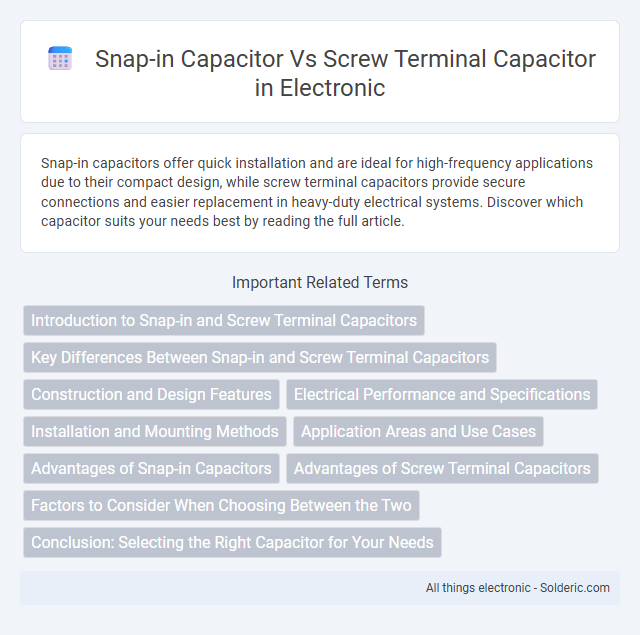Snap-in capacitors offer quick installation and are ideal for high-frequency applications due to their compact design, while screw terminal capacitors provide secure connections and easier replacement in heavy-duty electrical systems. Discover which capacitor suits your needs best by reading the full article.
Comparison Table
| Feature | Snap-in Capacitor | Screw Terminal Capacitor |
|---|---|---|
| Mounting Type | Snap-in pins for quick PCB installation | Screw terminals for secure wiring connections |
| Application | Common in power supplies, motors, and HVAC | Used in motor start/run and heavy-duty electrical devices |
| Current Rating | Typically lower current capacity | Higher current handling capability |
| Installation Speed | Faster, tool-less snap-in mounting | Slower, manual screwing required |
| Maintenance | Less accessible for repairs or replacements | Easier to disconnect and replace |
| Size & Dimensions | Compact design, standard pin spacing | Bulkier due to terminal screws |
| Reliability | Good for stable, vibration-free environments | Robust in high-vibration or heavy-duty environments |
| Cost | Generally lower cost | Typically higher cost due to robust connection |
Introduction to Snap-in and Screw Terminal Capacitors
Snap-in capacitors feature compact, easy-to-mount leads designed for quick insertion into circuit boards, offering high reliability in HVAC and motor applications. Screw terminal capacitors provide secure, robust connections through bolted terminals, ensuring stable performance in industrial and heavy-duty electrical systems. Your choice between snap-in and screw terminal capacitors depends on mounting preferences, electrical requirements, and maintenance needs.
Key Differences Between Snap-in and Screw Terminal Capacitors
Snap-in capacitors feature compact designs with quick installation through mounting clips, making them ideal for high-frequency applications and automated assembly lines, while screw terminal capacitors provide robust electrical connections via screw clamps suitable for high-current and heavy-duty equipment. Snap-in capacitors mainly target HVAC motors and compressors due to their high dielectric stability and vibration resistance, whereas screw terminal capacitors are preferred in industrial motor controls and power factor correction circuits for easier maintenance and secure wiring. The key differences lie in installation method, application suitability, and connection reliability, impacting performance in varied electrical environments.
Construction and Design Features
Snap-in capacitors feature metal leads designed for quick insertion into PCB terminals, enabling efficient automated assembly and secure mechanical stability. Their compact cylindrical aluminum electrolytic design includes aluminum foil electrodes and electrolyte, encased in a plastic sleeve with built-in safety vents. Screw terminal capacitors have robust metal connectors secured by screws, providing enhanced electrical contact and durability, suitable for applications requiring high current handling and vibration resistance.
Electrical Performance and Specifications
Snap-in capacitors typically offer higher electrical performance with superior withstand voltage ratings and lower equivalent series resistance (ESR) compared to screw terminal capacitors. These capacitors are preferred in applications requiring high ripple current handling and better thermal stability, often found in power supply circuits and motor run applications. Screw terminal capacitors, while easier to install and maintain, generally exhibit higher inductance and ESR, making them suitable for less demanding electrical environments or where mechanical robustness is prioritized over electrical efficiency.
Installation and Mounting Methods
Snap-in capacitors feature quick installation with their two metal leads designed to fit securely into printed circuit boards without tools, ensuring efficient mounting in tight spaces. Screw terminal capacitors require screws to attach wiring, offering robust mechanical connections ideal for applications demanding high vibration resistance and easy maintenance. Your choice depends on whether speed and compactness or strong, serviceable connections are paramount in your electrical design.
Application Areas and Use Cases
Snap-in capacitors excel in high-frequency applications such as power supplies, motors, and HVAC systems due to their secure mounting and compact design, which ensures reliable performance under vibration. Screw terminal capacitors are preferred in industrial machinery and heavy-duty electrical equipment where high capacitance values and easy maintenance are critical, allowing for robust connections and straightforward replacement. Your choice depends on the specific operational environment and mechanical requirements of your electronic or electrical system.
Advantages of Snap-in Capacitors
Snap-in capacitors offer superior vibration resistance and easier installation compared to screw terminal capacitors, significantly reducing assembly time in industrial applications. Their compact design provides enhanced reliability for motor run circuits in HVAC systems and other machinery, ensuring long-lasting performance. You benefit from improved mechanical stability and space-saving features that optimize electrical panel layouts.
Advantages of Screw Terminal Capacitors
Screw terminal capacitors offer superior electrical connections due to their robust and secure fastening method, minimizing resistance and enhancing durability in high-vibration environments. They provide easier maintenance and replacement options, making them ideal for industrial applications requiring frequent servicing. Your equipment benefits from improved reliability and longer operational life when using screw terminal capacitors over snap-in types.
Factors to Consider When Choosing Between the Two
When choosing between snap-in capacitors and screw terminal capacitors, consider installation speed and space constraints, as snap-in capacitors offer quicker assembly and compact design ideal for high-volume production. Evaluate electrical ratings and maintenance needs; screw terminal capacitors typically provide easier access for replacement and testing due to their secure, removable connections. Your decision should also factor in vibration resistance and application environment, with snap-in capacitors favored in stationary conditions while screw terminals are preferred in settings requiring robust mechanical stability.
Conclusion: Selecting the Right Capacitor for Your Needs
Snap-in capacitors offer quick installation and compact design, making them ideal for applications requiring space efficiency and ease of replacement. Screw terminal capacitors provide robust connections and are preferred in environments demanding high durability and secure mounting. Your choice should weigh factors like installation speed, mechanical stability, and maintenance requirements to select the capacitor that best fits your specific application.
snap-in capacitor vs screw terminal capacitor Infographic

 solderic.com
solderic.com